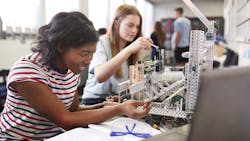Transform Manufacturing Education to Boost Productivity
If the findings in a recent American Society of Mechanical Engineers (ASME) study hold sway, the manufacturing industry must inspire a unique mix of employees and skill sets in order to stay competitive in a changing market that demands intelligent and sustainable products.
According to the report, Future of Manufacturing: New Workflows, Roles & Skills to Achieve Industry 4.0 Business Outcomes, emerging technologies—including design for manufacturing (DfM), operations technology infrastructure, artificial intelligence/machine learning technologies such as generative design, integrated software platforms, and centralized data management—will require new skills of mechanical and manufacturing engineers and machinists.
The research was conducted in partnership with Autodesk and is intended to provide guidance around advanced manufacturing in the future of work. The report pinpoints future workflows and skills needed for mechanical engineering, manufacturing engineering and CNC machinist roles over the next decade.
The study’s lead researcher, Ashley Huderson, PhD, who is also the director of Engineering Education and Outreach for ASME, said that each role will evolve separately, but that the necessary new skills applicable to all three of the roles will consist of “a combination of purposeful, common skills,” including hard and soft skills, as well as interdisciplinary skills.
“We saw that there will be a shift in job function and skills around all three areas, and then there is a convergence around cloud and data platforms, generative design data analytics,” Huderson told Machine Design during a WISE webinar.
Shifting Engineering Job Functions
As an example, she highlighted the role of the mechanical engineer, who is today primarily responsible for research, planning, design development and testing. “Most of them have at least a bachelor’s degree, and some have an associate degree or no degree, in terms of hard skills,” Huderson said. “We see that there’s going to be this general shift towards design for manufacturing, including knowledge of the subsequent manufacturing processes, knowledge of coding, 3D modeling, data, analytics, prototyping, as well as engineering simulation. We’re seeing this shift towards the incorporation of additional skill sets [for engineering technology] added to the basics of mechanical engineering.”
According to the study, 60% of the industry believe interdisciplinary engineering knowledge will increase for mechanical engineers over the next five to 10 years. This finding was consistent across small, medium and large manufacturers.
Academia is conspicuous in embracing new technologies such as generative design (GD), AI/ML and augmented reality/virtual reality (AR/VR). The study showed that 80% of academics believe GD application will be an important skillset and 67% believe AI or ML will be an important product design skill over the next decade.
A similar picture unfolded for manufacturing engineers, who will blend skills with both mechanical engineers and CNC machinists. Within industry, 72% of respondents believe human-robotic interaction will increase and 74% believe automation will increase for this role, noted the report. Along with enhanced communication skills, manufacturing engineers will be expected to incorporate additive manufacturing and be adept at employing artificial intelligence/machine learning (AI/ML), digital twins and data analytics to improve throughput and efficiencies.
The role of the computer numerical control (CNC) machinist will undergo significant changes, as well. The report noted that the CNC operator role will evolve to that of an engineering technician who programs CNC machines. These technicians will likely take on additional manufacturing engineering functions as the work environment is transformed.
Cultivating Soft Skills
The data further revealed a growing focus on software tool functionality, data analytics, programming and “smart” and sustainable design techniques is fostering an emphasis on soft skills such as problem solving and communication skills.
Huderson said that communication skills and other professional development skills are going to be critical in helping the upcoming workforce navigate their careers. “That includes your ability to communicate the work that you’re doing and how you’re doing it,” she said. “We could do all this amazing work, but if you can’t talk about it or write about it, it doesn’t go anywhere. It’s not shared with the field and doesn’t benefit the rest of your constituents.”
Certifications Over Degrees
The report, which is the culmination of surveys conducted with respondents in the U.S., Canada and UK, as well as an academic literature review and in-depth phone interviews, showed that 86% of academics not only embrace the idea that institutions should re-evaluate reliance on degrees, but they also favor specialized certifications in order to meet the changing industry demands. The majority of survey respondents (84%) noted that employers and academia should partner on new types of certification programs based on employer needs.
Across the board, the manufacturing industry is experiencing labor shortages that are expected to rise to about 2.1 million unfilled jobs by 2030, according to data compiled by Deloitte and The Manufacturing Institute.
Diversity, Equity and Inclusion
Huderson explained that some career trajectories don’t require a four-year degree. “There are other valuable ways to get into the workforce and provide exposure and training into that skill set,” she said.
On-ramps through certificates and technical training, said Huderson, will “allow individuals who normally may not have been at the table for various reasons, to come to the table with their solutions and their work.”
She added that this is particularly relevant for women and other identities that have been excluded historically from engineering and science. “Obtaining a degree has at times been a barrier for exclusion,” said Huderson. “Having financial and physical access to a four-year degree is not afforded to everyone.”
Prompted to cast a diversity, equity and inclusion (DEI) lens over the data, Huderson explained that the study did not disaggregate the data around historically marginalized identities. “We don’t speak to that in the data specifically, but those of us in this space understand the implications of this work,” Huderson said.
In the grand scheme, Huderson said, the data highlights where the talent is and signals industry to consider community colleges, technical spaces and anywhere individuals from diverse socioeconomic backgrounds tend to gravitate.
Editor’s Note: Machine Design's Women in Science and Engineering (WISE) hub compiles our coverage of gender representation issues affecting the engineering field, in addition to contributions from equity seeking groups and subject matter experts within various subdisciplines.
About the Author

Rehana Begg
Editor-in-Chief, Machine Design
As Machine Design’s content lead, Rehana Begg is tasked with elevating the voice of the design and multi-disciplinary engineer in the face of digital transformation and engineering innovation. Begg has more than 24 years of editorial experience and has spent the past decade in the trenches of industrial manufacturing, focusing on new technologies, manufacturing innovation and business. Her B2B career has taken her from corporate boardrooms to plant floors and underground mining stopes, covering everything from automation & IIoT, robotics, mechanical design and additive manufacturing to plant operations, maintenance, reliability and continuous improvement. Begg holds an MBA, a Master of Journalism degree, and a BA (Hons.) in Political Science. She is committed to lifelong learning and feeds her passion for innovation in publishing, transparent science and clear communication by attending relevant conferences and seminars/workshops.
Follow Rehana Begg via the following social media handles:
X: @rehanabegg
LinkedIn: @rehanabegg and @MachineDesign


